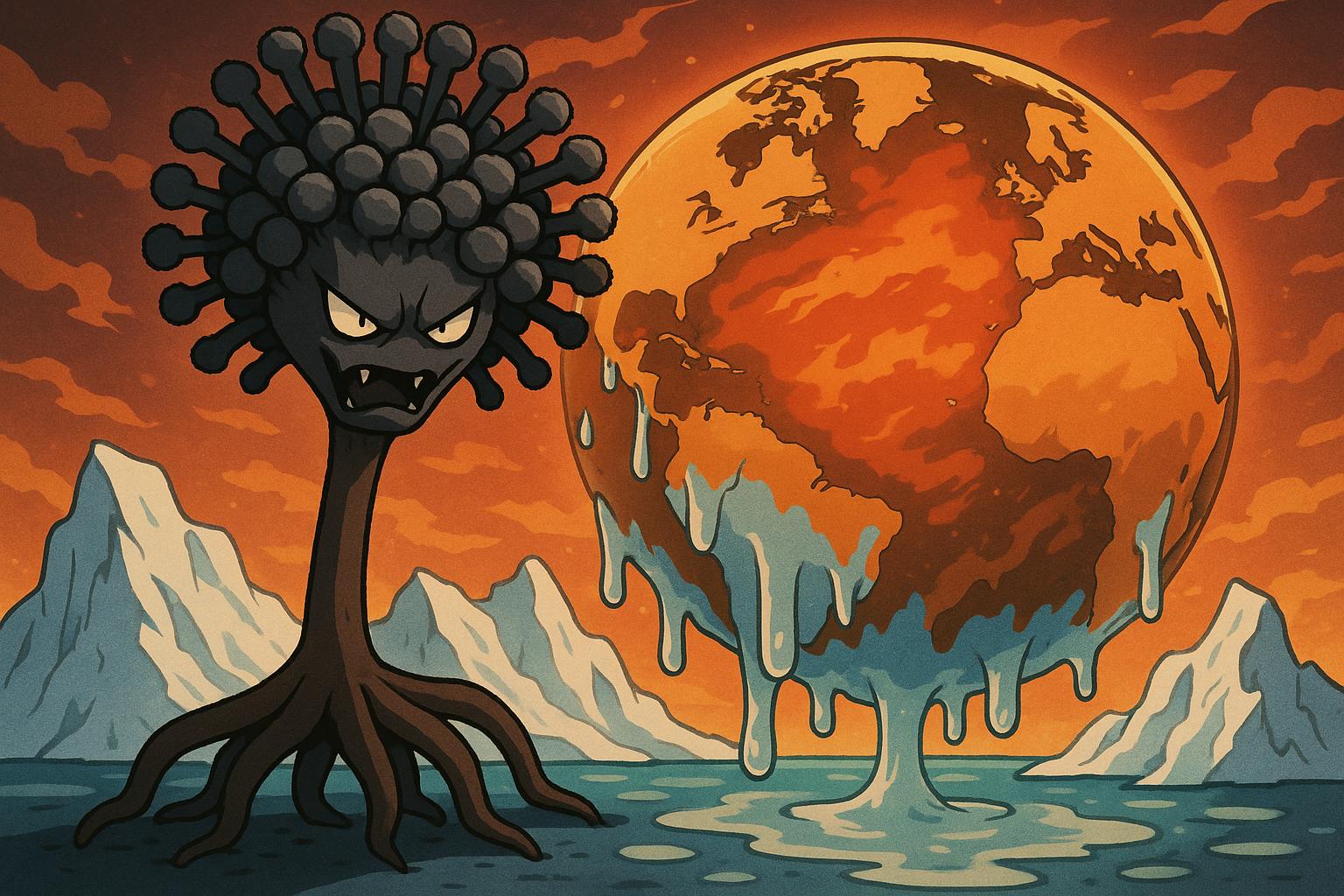New research reveals that rising global temperatures are expanding the habitat of harmful Aspergillus fungi across Europe, Asia, and the Americas. This shift increases risks of deadly lung infections and toxic crop contamination, posing urgent challenges for public health and food safety by the end of the century.
As global temperatures continue to rise, recent research sheds light on the geographical shifts of Aspergillus species—fungi with significant implications for both public health and agriculture. A study published in a preprint format on Research Square has modelled the current and future distribution of three prominent Aspergillus species—Aspergillus fumigatus, Aspergillus flavus, and Aspergillus niger—under various climate scenarios. This modelling aims to predict the impact of climate change on these pathogens, potentially reshaping the landscape of infectious disease and threatening the world’s food supply.
Aspergillus fungi are ubiquitous, thriving in soil, air, and even within homes, with healthy individuals typically able to tolerate inhaling numerous spores daily. However, for those with compromised immune systems, these fungi can cause severe infections. Particularly concerning is that Aspergillus fumigatus is listed as a critical fungal threat by the World Health Organization, responsible for a significant number of invasive aspergillosis cases that can ultimately lead to death. An expert panel reported that approximately 3.8 million people die annually from fungal infections, highlighting the growing urgency of this issue as climate change exacerbates conditions that allow these pathogens to thrive.
The research demonstrates that rising temperatures are enabling the northward expansion of Aspergillus species into previously unaffected regions across Europe, Asia, and the Americas. The modelling indicates that, under severe warming scenarios, habitat suitable for Aspergillus fumigatus could increase by as much as 77% by 2100, exposing potentially millions more people to its risks—isolated increases of up to 9 million individuals in Europe alone. Similarly, Aspergillus flavus, notorious for producing aflatoxins that are carcinogenic and dangerous to both crops and humans, is projected to expand its range by 16%, compounding concerns over food safety and public health.
The implications for global agriculture are alarming. Aspergillus flavus and Aspergillus niger are recognized for their impact on vital crops such as maize, rice, and wheat. The study reveals that overlap between these Aspergillus species and crop habitats is predicted to diminish significantly; for instance, the suitable habitat for Aspergillus flavus on maize could decrease from 19.1 million km² to just 6.8 million km² by 2090. This reduction raises critical alarms for food security as climate-related shifts in suitable habitats threaten to increase both human exposure to these fungi and the risk of crop contamination.
Significantly, environmental changes driven by temperature variations and altered precipitation patterns are not only shifting the geographic range of these fungi but also amplifying their impacts on human health and crop viability. Interdisciplinary studies have observed a direct correlation between the prevalence of these fungi in specific regions and the incidence of invasive infections, suggesting that local soil ecology plays a crucial role in shaping clinical outcomes.
Moreover, according to recent expert forecasts, climate change is anticipated to influence the rates of fungal contamination, particularly with aflatoxins. Instances of aflatoxin contamination have already increased in agricultural regions, a trend expected to worsen as climate conditions allow these toxins to thrive. Reports from Europe indicate that areas traditionally less affected by such contamination are now at risk, signifying a need for enhanced agricultural practices and biosecurity measures in the face of these evolving threats.
Dr. Norman van Rhijn, the lead author of the study from the University of Manchester, observed the broader implications: “While we have seen the emergence of Candida auris due to rising temperatures, we now face significant threats from other fungi like Aspergillus.” His concerns reflect the urgency for prioritising fungal research, particularly in areas where climate adaptation strategies must be developed to cope with shifting ecological dynamics.
The complexities of these interactions between climate change and fungal distributions not only pose challenges to public health and agriculture but also call for proactive surveillance and effective response mechanisms. Research highlighted by experts indicates that while we may face new and unexpected fungal threats, existing pathogens like Aspergillus may present the most significant ongoing challenges. The critical question for the future is how societies can adapt to avert the looming public health crisis posed by these resilient fungi.
In conclusion, the research underscores an urgent reality: climate change is reshaping the geographical distribution of Aspergillus species, posing serious threats to both human health and agricultural productivity. As suitable habitats for these pathogens migrate northward, and as aflatoxin levels are predicted to rise in food crops, immediate action is necessary to develop strategies that will mitigate risks and protect vulnerable populations from both the medical and agricultural consequences of these changes.
Reference Map:
- Paragraph 1 – [1], [2]
- Paragraph 2 – [1], [3]
- Paragraph 3 – [2], [4], [5]
- Paragraph 4 – [6], [7]
- Paragraph 5 – [1], [2], [3]
- Paragraph 6 – [1], [6]
- Paragraph 7 – [1], [4], [5]
Source: Noah Wire Services
- https://www.news-medical.net/news/20250526/Climate-models-predict-spread-of-deadly-Aspergillus-pathogens.aspx – Please view link – unable to able to access data
- https://www.ft.com/content/506f5a03-8520-40e1-aee3-a6e6427f68c0 – A recent study warns that climate change is accelerating the global spread of dangerous fungal pathogens, particularly Aspergillus species. Rising temperatures are enabling Aspergillus fumigatus and Aspergillus flavus to expand into northern regions of Europe, Asia, and the Americas. These fungi pose serious health risks, especially to individuals with weakened immune systems. Aspergillosis, a lung disease caused by inhalation of Aspergillus spores, results in hundreds of thousands of deaths annually, with many cases going undiagnosed due to unfamiliarity and symptom overlap with other conditions. Aspergillus fumigatus is on the World Health Organization’s list of critical fungal threats and may extend its territory by 77% by 2100, potentially exposing an additional 9 million Europeans. Aspergillus flavus, which infects crops and produces aflatoxins causing cancer and liver damage, could spread over 16% more land, raising concerns for both human health and food security. The increase is further amplified by extreme weather events like droughts followed by heavy rain, boosting spore dispersal. Despite the mounting threat, investment in antifungal treatments remains limited due to high costs and low profitability. Experts emphasise the urgent need for increased research and public awareness, as fungal diseases are projected to become a growing health crisis under climate change.
- https://www.ft.com/content/2df0ad08-65b6-483a-a59c-2af40d8afc23 – In January, Professor David Denning of the University of Manchester alarmed the public health community by publishing figures that doubled previous estimates on the incidence and mortality of invasive fungal infections. According to his article in The Lancet Infectious Diseases, 3.8 million people die annually from these infections, with the fungus being the primary cause in 2.5 million cases. This finding highlights the neglect of this factor in global mortality, now representing approximately 5% of all deaths, something that medical mycologists expect climate change to exacerbate. Denning clarifies that his methodology has been questioned but not dismissed. Climate change could worsen the situation by dispersing fungal pathogens through changing climatic conditions and extreme weather events. The expansion of habitable areas for fungi due to higher temperatures and changing rainfall patterns is an example. Research projects, such as the one funded by the US National Institutes of Health, aim to understand how climate change will affect the spread of fungal diseases by analysing medical data and using them to create predictive models. Denning anticipates that, although rare unexpected fungi may emerge, the biggest problems will continue to come from fungi like Aspergillus.
- https://www.cabidigitallibrary.org/doi/10.1186/s43170-024-00305-3 – Climate variations also impact contamination as they alter the host crops’ susceptibility to Aspergillus fungi, which produce aflatoxin. These modifications are associated with variations in crop growth and fluctuations in the population of insects that create wounds, serving as entry points for Aspergillus. A study supported by EFSA predicts that the danger of aflatoxin contamination in maize would increase due to climate change. An extensive evaluation of the literature revealed the need for interdisciplinary methods and more study to comprehend the relationship between mycotoxin co-occurrence and climate change. Aflatoxin contamination is increasing in continental regions in the middle latitudes (40°–55° North) because of global warming and rising greenhouse gas emissions. The primary fungi, Aspergillus flavus and A. parasiticus, are more likely to thrive and produce aflatoxin in response to rising temperatures, endangering the health of people, animals, and plants.
- https://www.aspergillus.org.uk/blogger/climate-change-is-predicted-to-increase-aflatoxin-levels-in-food-sources/ – Aspergillus and other fungi thrive on various organic substances, including agricultural crops intended for humans and animals. Numerous mould species, like Aspergillus, produce compounds known as mycotoxins. In relatively small quantities, which we ingest through normal consumption of food, mycotoxins have a very low risk of causing any adverse health effects. However, Aspergillus produces one of the most common mycotoxins – Aflatoxin – which has been demonstrated to be carcinogenic and associated with cirrhosis of the liver. Furthermore, those who are exposed to high levels of mycotoxins through dietary, inhalation, or epidermal means are likely to contract diseases known as mycotoxicoses. Although Aflatoxin is highly regulated in most countries, it can often contaminate food grains and has been well recognised as a public health issue for many years. Although aflatoxins are heavily regulated within Europe, it has now been indicated in a recent report that contamination of maize materials is predicted to rise significantly due to climate change. Battilani et al (2016) using a modelling approach of climate change, indicated that aflatoxin may become a more major issue in the agricultural industry, especially in a scenario where temperatures rise >2 degrees. If this model proves accurate, greater consideration must be given to reduce fungal growth of Aspergillus and other species on food sources in order to reduce disease risk in agriculture.
- https://www.eea.europa.eu/en/analysis/publications/mycotoxin-exposure-in-a-changing-european-climate – Under a +2°C temperature-increase scenario, the study predicts that aflatoxin contamination in maize will increase, particularly in southern Europe (Spain, Italy, and the Balkans). In a +5°C scenario, the contamination risk may decrease in southern regions due to extreme heat, but risks will widen geographically to include more northern European countries. For wheat, there are also increases in aflatoxin contamination, but these are higher in a +2°C temperature-increase scenario than a +5°C scenario (although with the latter, they are still higher than in the current meteorological scenario). For rice, the risk of contamination is negligible at harvest for all scenarios. This change in the spread of fungal species in Europe will alter exposure patterns, resulting in people being exposed to different mycotoxins with varying health effects. Contamination from multiple mycotoxins, including mixtures of aflatoxins, fumonisins, deoxynivalenol, and zearalenone, is expected to increase in crops, escalating human dietary exposure.
- https://pmc.ncbi.nlm.nih.gov/articles/PMC10379110/ – It is believed that temperature and humidity rises as a result of climate change are most probably responsible for the increased Aspergillus mycotoxins contamination witnessed in southern Europe from the early 2000s to the present; at the same time, a steady increase in contamination occurrence has been seen in northern Europe as well. Among Aspergillus mycotoxins, in previous decades, the most frequently detected were aflatoxin B1 in maize and aflatoxin M1 in milk. Reports from many European countries have indicated increased frequency of aflatoxins. For example, research conducted in two European countries, Croatia and Serbia, represents one of the most extensive investigations into the implications of climate change on the occurrence of aflatoxins, including data from a period of thirteen years. This study showed vast maize contamination during 2013 due to the climate impact seen across the 2012 maize cultivation season, the climate at the time practically mimicking tropical and subtropical conditions.













